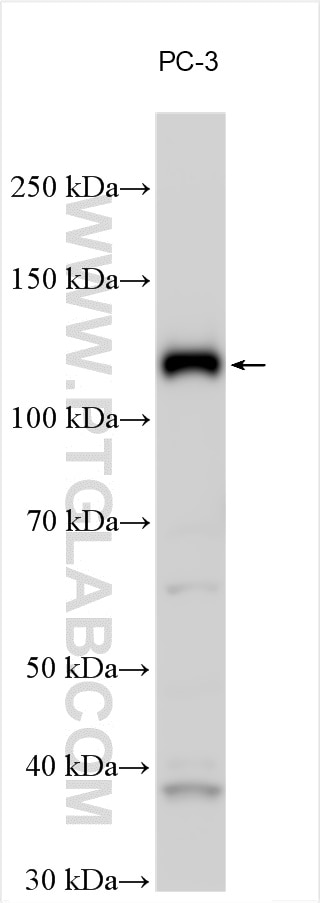IRE1; ERN1 Polyclonal antibody
IRE1; ERN1 Polyclonal Antibody for WB, ELISA
Host / Isotype
Rabbit / IgG
Reactivity
Human
Applications
WB, ELISA
Conjugate
Unconjugated
Cat no : 28164-1-AP
Synonyms
Validation Data Gallery
Tested Applications
| Positive WB detected in | PC-3 cells |
Recommended dilution
| Application | Dilution |
|---|---|
| Western Blot (WB) | WB : 1:1000-1:4000 |
| It is recommended that this reagent should be titrated in each testing system to obtain optimal results. | |
| Sample-dependent, Check data in validation data gallery. | |
Product Information
28164-1-AP targets IRE1; ERN1 in WB, ELISA applications and shows reactivity with Human samples.
| Tested Reactivity | Human |
| Host / Isotype | Rabbit / IgG |
| Class | Polyclonal |
| Type | Antibody |
| Immunogen | IRE1; ERN1 fusion protein Ag27375 |
| Full Name | endoplasmic reticulum to nucleus signaling 1 |
| Calculated Molecular Weight | 977 aa, 110 kDa |
| Observed Molecular Weight | 130 kDa |
| GenBank Accession Number | BC130405 |
| Gene Symbol | ERN1 |
| Gene ID (NCBI) | 2081 |
| Conjugate | Unconjugated |
| Form | Liquid |
| Purification Method | Antigen affinity purification |
| Storage Buffer | PBS with 0.02% sodium azide and 50% glycerol pH 7.3. |
| Storage Conditions | Store at -20°C. Stable for one year after shipment. Aliquoting is unnecessary for -20oC storage. 20ul sizes contain 0.1% BSA. |
Background Information
Inositol-requiring enzyme 1 (IRE1) is an ER transmembrane sensor that activates the UPR to maintain the ER and cellular function. Although mammalian IRE1 promotes cell survival, it can initiate apoptosis via decay of antiapoptotic miRNAs. IRE1 contains a ribonuclease domain in its cytoplasmic region which initiates splicing reaction by direct cleavage of XBP1 mRNA at the two stem loop structures. IRE1 plays instrumental protumoral roles in several cancers, and high IRE1 activity has been associated with poorer prognoses. (PMID: 23880584, PMID: 32861679, PMID: 31875595)
Protocols
| Product Specific Protocols | |
|---|---|
| WB protocol for IRE1; ERN1 antibody 28164-1-AP | Download protocol |
| Standard Protocols | |
|---|---|
| Click here to view our Standard Protocols |


